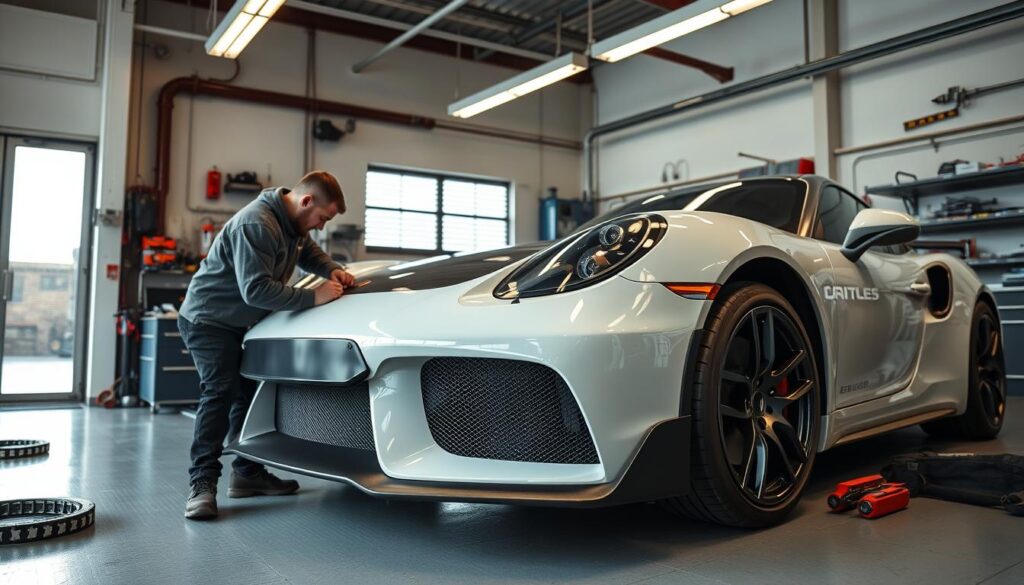Learn whether do you have to declare a front splitter on insurance and understand how modifications affect your coverage. Get expert insights on protecting your vehicle upgrades
Do you have to declare a front splitter on insurance ? Surprisingly, up to 70% of car enthusiasts are unaware of how vehicle mods like front splitters can impact their insurance, potentially leading to unexpected costs .
Adding a front splitter to your car does more than boost its looks. It also brings you into a world where insurance rules matter a lot. Getting the right insurance for your front splitter is key for car lovers who want to keep their vehicle safe.
Front splitters can make your car better to drive, but they also mean you need to think about insurance. Knowing the legal and money side of these car changes is important for car owners who want to do the right thing.
Key Takeaways
- Front splitters require specific insurance disclosure
- Modifications can impact insurance premiums
- Professional installation may affect coverage terms
- Failure to declare modifications can void insurance
- Different insurers have varying policies on vehicle upgrades
Understanding Front Splitters and Their Purpose
Front splitters are key aerodynamic parts that boost your car’s performance and handling. They attach to the front bumper, giving drivers a big advantage.
Car performance is about many things, and front splitters are a big part of it. They help manage airflow, making your car handle better.
Aerodynamic Benefits of Front Splitters
Front splitters manage air flow in a smart way. This brings many benefits:
- Reduce vehicle lift at high speeds
- Increase downforce for improved stability
- Enhance cornering grip and handling precision
- Optimize air circulation around the vehicle
Impact on Vehicle Performance
Front splitters change how your car performs. They help with weight distribution, improving traction and road contact.
| Performance Aspect | Splitter Impact |
|---|---|
| Cornering Stability | Increased Grip |
| High-Speed Handling | Enhanced Control |
| Aerodynamic Efficiency | Reduced Wind Resistance |
Types of Front Splitter Materials
There are many materials for front splitters, each with its own strengths:
- Carbon Fiber: Lightweight and very strong
- ABS Plastic: Affordable and impact-resistant
- Fiberglass: Flexible and light
“The right front splitter can transform your vehicle’s aerodynamic profile and performance characteristics.” – Automotive Performance Expert
Insurance Requirements for Vehicle Modifications
Modifying your vehicle? It’s key to know about car insurance modifications. Insurance companies have rules about vehicle upgrades. These rules can change your coverage and what you pay.
Here are some important things to think about for car insurance modifications:
- Performance-enhancing upgrades
- Aesthetic modifications
- Structural changes to your vehicle
- Safety-related alterations
Insurance companies need detailed records for big vehicle changes. Not telling them can cause problems with claims or even cancel your policy.
“Always inform your insurance provider about vehicle modifications before they become an issue.” – Insurance Expert
Each type of modification affects insurance differently. Here’s a quick guide on how:
| Modification Type | Insurance Risk Level | Potential Premium Impact |
|---|---|---|
| Performance Upgrades | High | Significant Increase |
| Cosmetic Changes | Low | Minimal Increase |
| Safety Enhancements | Low | Potential Decrease |
| Structural Modifications | Very High | Substantial Increase |
To keep yourself safe, always talk openly with your insurance provider. Keep records of all changes, save receipts, and ask for a policy update that shows your car’s current state.
Do You Have to Declare a Front Splitter on Insurance
Vehicle modifications can be tricky when it comes to insurance rules. Knowing what you must declare about your front splitter is key. It helps keep your insurance valid and avoids big financial problems.
Legal Obligations for Modification Disclosure
After putting a front splitter on your car, telling your insurance is very important. Most insurers want you to say if you’ve made any changes that could change how your car works or its value. Not telling them about your front splitter can cause big trouble.
- Notify your insurance company immediately after installation
- Provide detailed specifications of the front splitter
- Submit professional installation documentation
- Update your policy to reflect the modification
Consequences of Non-Declaration
If you don’t tell your insurance about the front splitter, you could face big issues. Your insurance might:
- Invalidate your entire insurance policy
- Reject potential claims
- Retroactively cancel your coverage
“Transparency with your insurance provider is key to maintaining comprehensive protection for your modified vehicle.”
Insurance Premium Impact
Telling your insurance about the front splitter might change your rates. Insurers look at how your car’s changes affect its performance and value. Some changes might raise your rates, but others might not.
Having professional papers and safety checks can help lower the chance of your rates going up because of the front splitter.
Cost Implications of Installing Front Splitters
When you think about installing front splitters, several key factors come into play. These factors affect how much you’ll spend on your vehicle. The cost of front splitters can vary a lot. This depends on the material, your car’s model, and the design’s complexity.
- Entry-level universal splitters: $50-$150
- Vehicle-specific performance splitters: $200-$500
- Professional carbon fiber splitters: $500-$1,200
- Installation labor: $100-$300 additional
How much you’ll spend on your vehicle’s modifications can change a lot. Performance enthusiasts should look for high-quality materials. These materials improve your car’s aerodynamics. Cheaper options might save money at first but could not last as long.
“Investing in a high-quality front splitter is about performance, not just aesthetics.” – Automotive Performance Experts
Getting a pro to install your front splitter can cost $100-$300 more. If you do it yourself, you can save money. But, making sure it’s done right is important for both performance and safety.
Also, installing a front splitter might change your insurance rates. Always talk to your insurance company. They can tell you how your car’s changes might affect your premiums.
How Front Splitters Affect Vehicle Value
When you think about modifying your car, knowing how it affects resale value is key. Front splitters can really change how much your car is worth and its long-term financial health.
Adding front splitters to your car brings both good and bad. They can make your car go faster, but they also raise questions about warranty.
Impact on Resale Value
The value of your car with front splitters depends on a few things:
- How well they were installed
- The type of car you have
- What buyers in the market want
- Whether you did it yourself or had a pro do it
Good, professional front splitters from known brands might attract buyers who love speed.
Warranty Considerations
Modifying your car can mess with your warranty. Companies often see extra parts as risks to their designs.
| Modification Type | Potential Warranty Impact | Recommended Action |
|---|---|---|
| Professional Front Splitter | Minimal Risk | Document Installation |
| DIY Front Splitter | High Risk | Consult Manufacturer |
“Always verify modification details with your vehicle manufacturer to protect your warranty coverage.”
Choosing and installing front splitters wisely can keep your car’s value up while making it faster.
Professional Installation vs DIY: Insurance Perspective
Insurance companies look closely at how you install car mods like front splitters. They prefer professional upgrades because they are done right and meet quality standards.

Choosing between DIY and professional car upgrades affects your insurance. Insurers trust professional installs more. They know these jobs are done well, ensuring:
- Proper fitment and alignment
- Compliance with manufacturer specifications
- Reduced risk of potential damage
- Enhanced vehicle safety standards
Professional installation has big benefits for your insurance:
| Installation Type | Insurance Risk Assessment | Potential Coverage Impact |
|---|---|---|
| DIY Modifications | Higher risk | Potential coverage limitations |
| Professional Upgrades | Lower risk | More likely full coverage |
*”Precision matters more than passion when modifying your vehicle”* – Professional Auto Modification Expert
Some insurers might ask for proof of professional installation for full coverage. Getting expert installation can avoid insurance issues and protect your vehicle.
Common Insurance Company Policies on Splitters
Getting insurance for car mods can be hard, especially for things like front splitters. It’s important to know what insurance companies say about these upgrades. This helps keep your car safe and covered.
Insurance companies handle car upgrades differently. About 65% of them need detailed info for things like front splitters.
Coverage Limitations for Vehicle Modifications
Insurance policies have rules for car mods. Here are some key ones:
- Mods might raise your insurance cost
- Not telling about mods can lead to no coverage
- Insurance checks how your car is changed
Documentation Requirements
Insurance wants to see proof of your car’s changes. You’ll need:
- Certs from pro installers
- Receipts for the work done
- Photos of the new parts
- Details about the splitter
“Being open with your insurance is key to keeping full coverage for your car.” – Automotive Insurance Expert
Not telling about car changes can up your risk by 40%. Insurance uses these papers to figure out the risks of your car’s upgrades.
Risk Assessment for Modified Vehicles

When you add performance upgrades to your car, like front splitters, insurance companies do a thorough check. They look at how these changes affect your insurance rates and coverage.
Insurers check a few important things about your car’s upgrades:
- How much they boost your car’s performance
- The quality of the materials used
- If the installation was done right
- How these changes might affect how your car handles
Keeping your car safe is a big deal for insurance companies. They want to know how your car’s design and performance might change with upgrades.
Here are some key things insurers look at:
| Risk Category | Assessment Criteria | Potential Impact |
|---|---|---|
| Structural Integrity | Material Quality | Higher Premium |
| Performance Modifications | Speed and Handling Changes | Increased Accident Risk |
| Installation Method | Professional vs DIY | Coverage Limitations |
“Understanding your vehicle’s modified risk profile is crucial for maintaining appropriate insurance coverage.” – Insurance Risk Specialist
Talking to your insurance about your car’s upgrades can help. It ensures you get the right coverage and might avoid unexpected issues.
Warranty and Insurance Compatibility
When you add performance upgrades like front splitters to your car, it’s key to know how they affect your warranty. These changes can mess with your car’s original warranty and insurance.
Car owners need to think about a few things when they modify their vehicles:
- Potential voiding of manufacturer warranty
- Insurance restrictions on vehicle upgrades
- Specialized coverage requirements
- Impact on overall vehicle protection
Manufacturer Warranty Implications
Aftermarket parts can hurt your car’s warranty. Car makers have rules against unauthorized changes. Adding parts like front splitters might make your warranty useless.
Insurance Coverage Restrictions
Insurance companies are careful with car changes. They want to know about any upgrades. Your insurance might:
- Need you to report any changes
- Change your premium
- Ask for special coverage
- Limit coverage for certain parts
“Always talk to your manufacturer and insurance before making car changes to know the risks.” – Automotive Expert
Telling your insurance about upgrades can keep your coverage strong. It helps avoid big financial surprises.
Safety Considerations and Insurance Impact
Front splitters are key to your car’s safety and insurance. Knowing how they affect your vehicle is important. This knowledge helps you make smart choices about your car’s look and performance.
Front splitters can change how your car handles and its safety. Insurance rules need you to think about how these changes might affect your car. Here are some safety points to consider:
- Aerodynamic stability at high speeds
- Potential changes in vehicle weight distribution
- Impact on suspension and steering response
- Material durability and structural integrity
Insurance companies look closely at how car mods affect safety. Improperly installed front splitters can create significant risks that may raise your insurance costs or limit coverage.
“Safety should always be the primary consideration when modifying your vehicle” – Professional Automotive Engineer
| Safety Factor | Potential Risk | Insurance Consideration |
|---|---|---|
| Incorrect Installation | Reduced Vehicle Stability | Higher Premium Risk |
| Low-Quality Materials | Potential Structural Failure | Coverage Restrictions |
| Improper Aerodynamics | Handling Performance Issues | Safety Rating Impact |
To keep your car safe and your insurance in check, always get professional help. Also, tell your insurance about any car changes you make.
Conclusion
Knowing about front splitter insurance is key for car owners who want to modify their vehicles. Your car’s changes can affect your insurance and money risks. It’s important to think about these things before adding a front splitter.
Talking to your insurance company early is a must. Each company has its own rules for car changes. Not telling them can lead to no coverage or even canceling your policy. Being open about your car’s changes helps keep it safe and your wallet safe too.
Getting a front splitter means doing your homework and talking to experts. Think about how it might change your car’s performance, value, and insurance needs. With the right planning, you can protect your car and keep it in top shape.
Getting advice from pros is the best way to deal with car changes and insurance rules. By understanding these, you can make smart choices. This balances looks with insurance needs.


